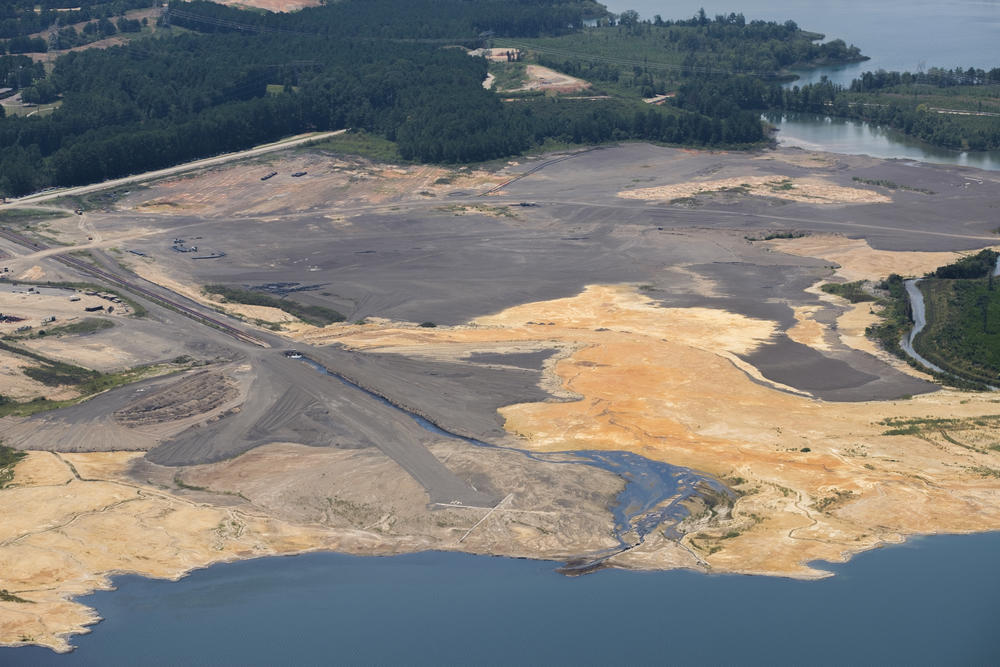
Caption
Coal ash as it leaves Georgia Power's Plant Scherer and settles into the ash pond adjacent to the plant.
Credit: Grant Blankenship/GPB file photo

Coal ash as it leaves Georgia Power's Plant Scherer and settles into the ash pond adjacent to the plant.
Four coal ash ponds Georgia Power plans to close in place will continue to expose ash to groundwater after the closures are completed, an executive with the utility disclosed this week.
Ash ponds at Plant Hammond near Rome, Plant McDonough south of Vinings, Plant Yates near Newnan and Plant Scherer near Macon are among 10 ash ponds Georgia Power plans to close in place by 2028. Ash from the utility’s other 19 ponds at coal plants across Georgia will be closed by excavating and removing the ash.
Aaron Mitchell, Georgia Power’s director of environmental affairs, testified on the second of two days of hearings before the state Public Service Commission (PSC) on a plan the utility submitted in January outlining the mix of energy sources it intends to rely on for power generation during the next 20 years.
Georgia Power’s 2022 Integrated Resource Plan (IRP) calls for the company to continue phasing out its fleet of coal-burning plants and stepping up its investment in natural gas and renewable energy. With the coal plants being retired, the utility plans to spend $9 billion to close all 29 of its coal ash ponds.
Coal ash contains contaminants including mercury, cadmium and arsenic that can pollute groundwater and drinking water as well as air.
The U.S. Environmental Protection Agency (EPA) put utilities on notice in January that it would require them to “control, minimize or eliminate” contamination of groundwater from ash ponds. At that time, the EPA rejected four ash pond closure plans submitted by utilities in the Northeast and Midwest.
After its announcement, the EPA’s Office of Resource Conservation and Recovery sent a letter asking the Georgia Environmental Protection Division (EPD) to review pending coal ash pond closure permits to determine whether they need to be modified or reissued.
While excavating and removing coal ash from ponds would make sure no groundwater contamination occurs, Mitchell testified the EPA has declared both removal and closure in place are acceptable.
“EPA has said both methods are equally as protective of the environment if the performance standards are complied with,” he said. “We believe our designs are compliant.”
But that statement seems to conflict with the EPA rule change released in January.
"The proposed determinations re-state EPA’s consistently held position that surface impoundments or landfills cannot be closed with coal ash in contact with groundwater," read the press release from the EPA which also described how any state permits for coal ash storage, including those made by the Georgia Environmental Protection Division, would have to clear the EPA first.
The EPD issued a preliminary permit last year for closing the ash pond at Plant Hammond. Environmental groups and nearby residents have protested because some of the ash is sitting in groundwater.
Also, a 2020 lawsuit by Juliette residents against Georgia Power associated with groundwater contamination in the vicinity of Plant Scherer remains pending.
Georgia Power plans to offset some of the costs of closing the ponds by selling recovered ash for use in building materials, although some investment will be required for the infrastructure needed to update the ash to construction standards.
Mitchell said initially only about 10% of the ash will be recovered for “beneficial use.” Ultimately, however, the “vast majority” of the ash will be used, subject to market demand,” he said.
“The larger impact and larger value are from the reduction in the amount of ash and the value of the ash we actually have to close,” he said. “The benefits more than pay for themselves in the long term.”
This story comes to GPB through a reporting partnership with Capitol Beat News Service, a project of the Georgia Press Educational Foundation.